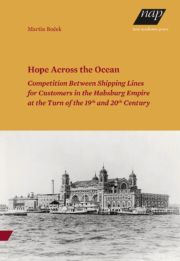Martin Boček
Hope Across the Ocean
Competition Between Shipping Lines for Customers in the Habsburg Empire at the Turn of the 19th and 20th Century

€ 28.00
The book primarily looks at the operation of shipping companies in Austria-Hungary while also providing insight into the phenomenon of emigration during the period of mass migration to the USA. In terms of time, the book primarily looks at the last two decades of the long 19th century, incorporating the period up until the outbreak of the First World War in 1914. It was during this period that emigration from the Habsburg Monarchy reached its peak, and it was a golden era for shipping. As such, the book focuses its attention on a relatively narrow set of selected shipping companies which were the most used for emigration out of the monarchy at the end of the 19th century. While there were many companies operating in Europe, this study focuses its attention on the most important, which were most relevant for the monarchy’s residents. The author has chosen the two largest German shipping lines for his comparison, Hamburg Amerikanische Paketfahrt Aktien-Gesellschaft (HAPAG), operating a route from Hamburg, and Norddeutsche Lloyd. He primarily compares these two companies with Austria’s own Vereinigte Österreichische Schiffahrts-Aktien-Gesellschaft, vormals Austro-Americana &Fratelli Cosulich (Austro-Americana) and Britain’s Cunard Line, which operated within the Habsburg market essentially as a foreign element, even though it had acquired a privileged position from the Hungarian government.
A fundamental part of the book then looks at the course of emigrants’ journeys, and also at the northern and southern routes for emigrants, which logically went via the northern German ports or via the port cities in the south of the Habsburg Monarchy. The author focuses in particular on the competition between shipping companies, which took place separately geographically, i.e. in the north and in the south separately. There was an evident overall interconnection of shipping companies in the period prior to the outbreak of the First World War, and agreements directly determined individual factors in the competition between them, these including price of transport, frequency, and destination of routes from Europe to the USA, comfort levels provided to customers, speed of transport and range of services provided. Despite the determined quotas for numbers of carried passengers and agreements on the price of ship tickets, competitive rivalry between the companies was still ongoing by 1914.